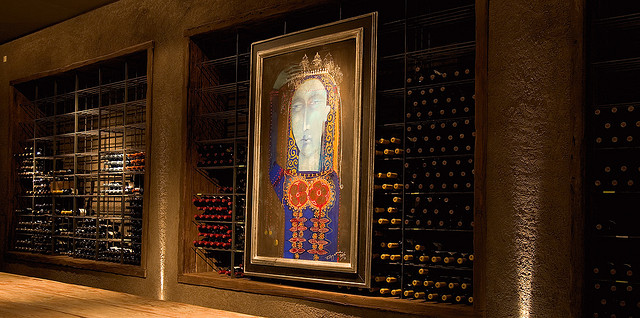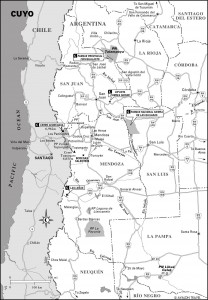
O. Fournier private room. Photo © David, licensed Creative Commons Attribution.

Cuyo
About an hour southwest of Mendoza, near the towns of Tupungato and Tunuyán, the Uco Valley is increasingly important, but its wineries are more scattered than those around Mendoza. That may well change, as it’s the site of some ambitious wine development and real-estate projects.West of RN 40, near the town of Tupungato, Giaquinta is a cluttered but cozy family winery that won’t quite drop everything to accommodate visitors, but they’ll do their best to keep the wait short. While it lacks the slick professionalism of many Mendoza wineries, the Spanish-only tours, led by family members and regular employees, communicate their enthusiasm for wine and the winemaking process, with a generous tasting on top of that. Bodegas y Viñedos Familia Giaquinta (Carril Zapata s/n, La Arboleda, Tupungato, tel. 02622/48-8090) is open for tours Monday–Saturday during normal business hours.
On the plains at the edge of the Andes, O. Fournier is a sprawling vineyard-winery complex with a gourmet restaurant just a few kilometers west of RN 40 at 1,100 meters above sea level. Landscaped with drought-tolerant plants and gravel that mimics a stream bed, built of reinforced concrete, the winery proper employs the latest technology — sleek presses and stainless steel vats — but produces finely tuned premium Syrah, malbec, and cabernet aged in French and American oak. Its Urban line, however, has excellent affordable varietals such as tempranillo and torrontés as well as some blends, and the barrel-filled cellars also contain a fine contemporary art collection.
O. Fournier (Calle Los Indios, La Consulta, San Carlos, tel. 02622/45-1088) 130 kilometers south of Mendoza by smoothly paved RN 40, is open for guided tours (US$4, with a sample from the Urban line) by reservation only 9:30 a.m.–4:30 p.m. daily. More elaborate tastings, at prices ranging US$10–20, are also available.
Five-course lunches and dinners at Fournier’s sophisticated Urban restaurant, which faces a pond where wildfowl take a breather, range US$23–47, depending on the wines (or lack of) that accompany the meal; the vineyards and the Andean front range are also part of the view. Fournier also offers morning horseback rides (US$37) that include breakfast, but lunch is extra, depending on the option chosen.
Built by Dutch capital near the Andean foothill town of Tunuyán, Bodegas Salentein (RP 89 s/n, Los Arboles, Tunuyán, tel. 02622/42- 9500) is a futuristic — one might even say New Age — winery with a contemporary aesthetic sensibility. At ground level, stainless-steel tanks hold the wine in four separate wings, each of which operates autonomously; eight meters below ground level, forming the an equilateral cross, the four wings meet in a subterranean central amphitheater where the subdued light on circular rows of oak barrels creates a cathedral atmosphere. It is, in fact, a temple of wine.
On top of that, Salentein has created a separate structure as the Galería Killka, with collections of late-19th-century and early- 20th-century Dutch art (mostly landscapes) and more innovative contemporary works by regional artists. In the same building, its new restaurant, with magnificent Andean and vineyard views, as well as a wine shop, are making Salentein an international destination.
At 33° south latitude, Salentein’s vineyards enjoy sunny days and cool nights (the annual average temperature is 14°C) on rocky alluvial soils at a mean elevation of 1,250 meters. Ranging 1,050–1,500 meters above sea level, the vineyards are up to 30 years old, but new plantings are also underway.
Guided tours, which cost US$2.50 pp in Spanish or English (usually less crowded), take place hourly 10 a.m.–4 p.m. Monday–Saturday. Rates include admission to the gallery and a tasting of one red and one white. Bodegas Salentein can be most easily reached by private car or by remise from Tunuyán, 82 kilometers south of Mendoza via RN 40. Tunuyán is 17 kilometers east of Salentein.
There are 16 double rooms available at Posada Salentein (Emilio Civit 778, Mendoza, tel. 0261/441-1000) in several buildings in an isolated part of the vineyard that has a trout-stocked reservoir. Rates are US$260–327 s or US$303–363 d with half board, including wine and some activities like hiking and horseback riding, along with tours of the bodega. Lunch costs an extra US$40. Argentine residents pay about one third less for accommodations.
Excerpted from the Third Edition of Moon Argentina.